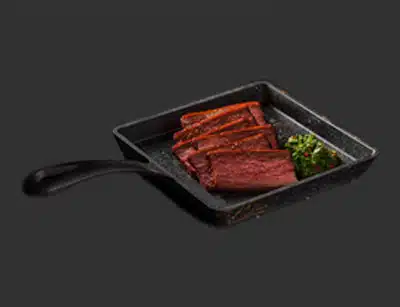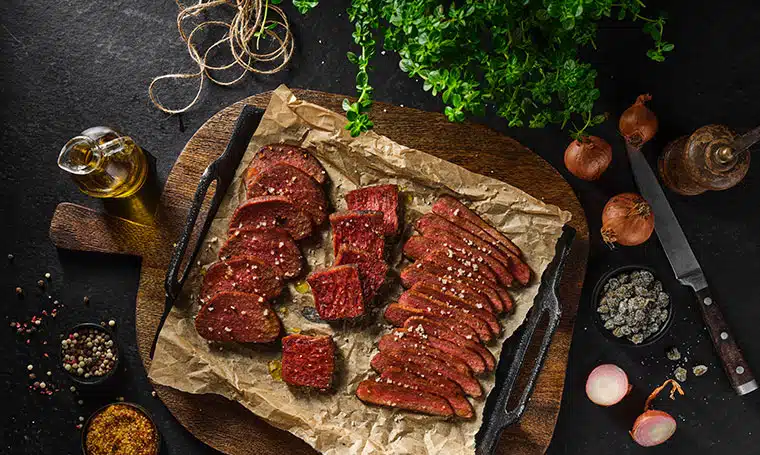
What’s on Your Plate? Exploring the Key Nutritional Values of Red Meat vs. New-Meat
As more and more people try to cut down on their meat consumption for ethical, environmental, or even health reasons, plant-based alternatives have become more popular. Until recently, consumers knew this meant compromising on taste. However, thanks to the introduction of new-meat, which is produced from plant-based sources and closely replicates animal meats in terms of flavor, texture and nutritional values, consumers can enjoy a plant-based food alternative without sacrificing the meat-eating experience.
In this post, we take a closer look at the similarities and differences between new-meat and traditional red meat and see how they compare in terms of nutritional values like protein, fat content and micronutrients.
Giving Red Meat its fair due
Due to its potential health implications, red meat is often portrayed in a negative light. Throughout human evolution, red meat has been an important part of the human diet. It’s not difficult to see why. When included as part of a healthy, varied diet, red meat provides a rich source of protein with a high biological value, containing all the essential amino acids and other essential nutrients. Some of these nutrients, like iron, are more bioavailable – easier for your body to digest and absorb, than in alternative plant-based food sources.

Muscle-Building Proteins: Red Meat vs. New-Meat
Proteins play a key role in the growth, maintenance, and repair of the body, and make up a vital part of well-balanced diet. Red meat contains on average 20 – 24 g protein per 100 g and is considered a high source of protein. New-meat, which is made from plant-based ingredients such as soy, peas, wheat etc., mimics the nutritional values of animal meat by providing similar amounts of high-quality protein.
For those looking for a healthier, environmentally friendly protein option, new-meat is a good choice. Combining several sources of plant-based protein such as legumes and grains creates a complete protein packed with all the essential amino acids you’d find in red meat.
Just as every cut of traditional meat varies, so too does the protein content of premium cuts of new-meat. As a guide, the protein content in new-meat can range from around 16 g to nearly 26 g per 100 g serving.
Red Meat vs. New-Meat: What about those saturated fats?
Consuming too much saturated fat can raise your cholesterol levels and increase the risk of heart disease. The American Heart Association even recommends limiting saturated fat to less than 5-6 percent of one’s daily calorie intake.
The fatty acid profile of red meat will vary depending on the proportions of lean meat and fat present. However, in general, red meats have more saturated fat than skinless chicken, fish, and plant proteins. In contrast, one of the main advantages of new-meat is that it is typically lower in saturated fat than animal meat and contains no cholesterol whatsoever. Good news for people looking after their heart and cardiovascular health.
Foodies know that fat content also plays an important role when it comes to replicating the rich taste profile, juiciness, and tenderness of animal meats. New meat achieves these attributes using ingredients with fats from coconut or rapeseed oils. This keeps dishes flavorful but low in saturated fat and cholesterol.

Red Meat vs. New-Meat: What about iron and other micronutrients?
Red meat provides a wide range of bioavailable micronutrients which are required for general health and wellbeing. Chief among these is iron, a mineral used by the body to produce the hemoglobin in our red blood cells responsible for transporting oxygen from around the body.
Another way new-meat products mimic the nutritional values of animal meat is by providing essential vitamins and minerals. Indeed, plant-based new-meat is fortified with iron, zinc, and vitamin B12 – micronutrients commonly found in animal products.
New-meat: A healthy and nutritious, protein-rich food for meat-loving flexitarians
So, in summary, how do red meat and new-meat stack up against each other? Both can certainly be a part of a heathy and balanced diet and offer a high proportion of bioavailable protein.
On the one hand, animal meat can contain more micronutrients and is a rich source of certain nutrients. Overall, new-meat products aim to provide flexitarians with a similar nutritional profile to animal meat, while also offering some unique benefits such as being lower in saturated fat and cholesterol free. You can learn more about a plant-based diet in this article.
Other important differences are environmental impact, and of course a clean production process which means new-meat is free from the antibiotics and hormones typically used in raising animals grown for meat.
One final question remains. How does new-meat compare to traditional meat in terms of the culinary experience? We’ll let you be the judge.
Nadya Gurevich. RD, is a nutrition expert and an integral part of Redefine Meat’s research and development team.
To learn more about new-meat from Redefine Meat and to discover our range of delicious new-meat click here.





